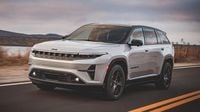For many car lovers, memories of certain discontinued vehicles evoke a potent mix of nostalgia and admiration. These machines, once mainstays on American roads, have become treasured icons, their absence felt deeply among gearheads and collectors alike. While the auto industry is always in flux—models come and go, and new technologies rise to prominence—some cars leave a legacy that lingers long after the last one rolls off the assembly line.
Take the AMC Eagle, for instance. Produced from 1980 to 1988, this off-road sedan was ahead of its time, marrying the practicality of a compact car with the ruggedness of a Jeep. According to FinanceBuzz, the Eagle featured a revolutionary full-time four-wheel-drive system and extra ground clearance, distinguishing it from its peers. With about 200,000 units produced, the Eagle’s innovative spirit arguably foreshadowed today’s crossover SUV craze. Yet, when Chrysler took over AMC in 1987, the Eagle’s journey ended, with the final models hitting dealerships a year later.
Japanese engineering also made a lasting impression with the Mazda RX-7. From 1978 until 2002, this sleek sports car captured the hearts of enthusiasts, thanks in large part to its legendary rotary engine. As reported by FinanceBuzz, the RX-7 was renowned for its zesty handling and surprising fuel economy, selling around 503,000 units during its lifetime. However, unfavorable economic conditions, dwindling demand, and rising production costs led Mazda to discontinue the RX-7, leaving fans longing for its return.
British flair found a champion in the Lotus Esprit, a car that achieved pop culture fame with appearances in the James Bond film "The Spy Who Loved Me" and the 1980s classic "Pretty Woman." Lotus produced 24 different Esprit models between 1976 and 2004, totaling 10,675 units. Its wedge-shaped design and performance made it a symbol of 1970s and 80s automotive luxury. Lotus managed to keep the Esprit in production for nearly three decades, but eventually, changing tastes and stricter regulations spelled the end for this icon.
Stateside, the Pontiac Fiero stands out as a bold experiment from General Motors. Produced from 1983 to 1988, the Fiero was notable for its plastic body panels and mid-engine layout—a rarity for American cars. Over 300,000 units were built, but issues ranging from safety concerns to the Fiero’s limited practicality led to its demise. Still, for a brief, shining moment, the Fiero represented American ingenuity and the willingness to take risks in design.
The Honda S2000, meanwhile, holds a special place in the hearts of millennials and fans of the "Fast and Furious" franchise. This high-revving, two-seater roadster was produced from 1999 to 2009, with around 111,000 units made. Its nimble handling and affordability made it a favorite among driving enthusiasts. However, the 2008 auto industry crisis forced Honda to end the S2000’s production, a move lamented by many who considered it a modern classic.
Some vehicles, like the Dodge Viper, are remembered as much for their audacity as their performance. Produced from 1992 to 2017, the Viper was a true beast, with Car and Driver dubbing it a "kind of automotive Everest." Fiat-Chrysler sold about 31,850 Vipers over its lifespan. The car’s demise was due in part to its inability to accommodate mandatory side curtain airbags and declining sales. Yet, its legacy as a raw, unfiltered driving machine lives on.
Not all classics were sports cars. The Chevy Nova, a compact pony car, was a fixture on American roads from 1962 to 1979 and made a brief comeback from 1985 to 1988 through a partnership with Toyota. Despite impeccable manufacturing, the reintroduced Nova failed to capture the imagination of car enthusiasts as its predecessors had.
Then there’s the Ford Thunderbird, a name that conjures images of speed, luxury, and NASCAR glory. Ford produced 16 generations of the Thunderbird between 1955 and 2005, with roughly 4.4 million units manufactured. The T-Bird’s enduring appeal prompted Ford to launch a retro-inspired model in 2001, but by 2005, the curtain fell on this storied coupe.
The Datsun 510, produced between 1968 and 1973, is credited with paving the way for affordable, sporty sedans. Around 360,000 units were sold, and its influence can still be seen in today’s Nissan Maxima and Altima. The 510’s blend of style, efficiency, and fun-to-drive character made it a favorite among Sports Car Club of America racers and everyday drivers alike.
No list of American classics would be complete without the Chevy Bel Air. Produced from 1950 until 1975, the Bel Air was a mainstay for Chevrolet, with some years seeing over a million units produced annually. The "Tri Five" models from 1955 to 1957 are particularly prized, with mint-condition examples fetching sky-high prices at auction—one sold for as much as $440,000, while another brought in over $182,000, according to FinanceBuzz. For collectors, these cars are more than nostalgic relics; they’re smart investments.
The enduring fascination with these discontinued vehicles highlights a broader trend in the automotive world: the tension between innovation and nostalgia. As technology advances and regulations evolve, automakers must constantly adapt. This dynamic was on full display in September 2025, when Antonio Filosa, newly appointed head of Stellantis, announced a pivot back to V-8 performance engines and a tempering of the company’s electric vehicle ambitions. According to recent reports, Stellantis’s strategic shift reflects both market realities and the enduring appeal of classic performance cars.
Filosa’s move comes at a time when many in the industry are reassessing the pace of electrification. While electric vehicles promise a cleaner future, there’s still a powerful emotional connection to the roar of a V-8 or the unique feel of a manual gearbox. For some, these elements are irreplaceable—and with good reason. Cars like the Dodge Viper or Ford Thunderbird weren’t just modes of transportation; they were statements of identity, freedom, and innovation.
For collectors and enthusiasts, the market for classic cars remains robust. As FinanceBuzz notes, rare and well-kept models like the 1955 Chevy Bel Air can command small fortunes, making them not just sentimental treasures but also financial assets. This intersection of passion and investment ensures that the legends of the past will continue to influence both the present and the future of the automotive world.
Ultimately, while new technologies and shifting consumer preferences will shape tomorrow’s roads, the legacy of these discontinued classics endures. Whether in the form of restored showpieces, cherished memories, or the design cues of tomorrow’s cars, their influence is unmistakable—and their stories are far from over.




